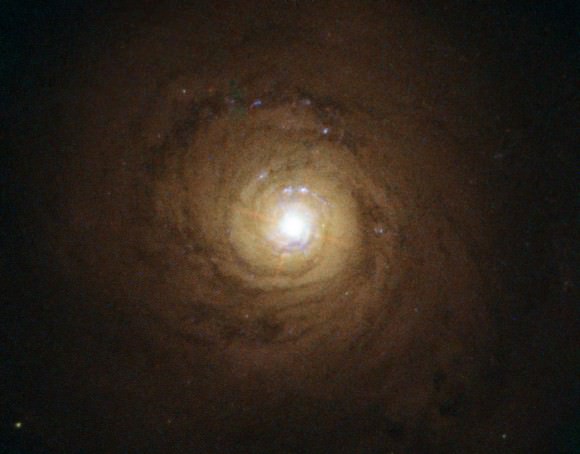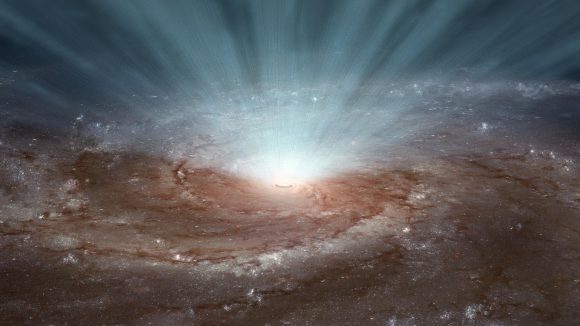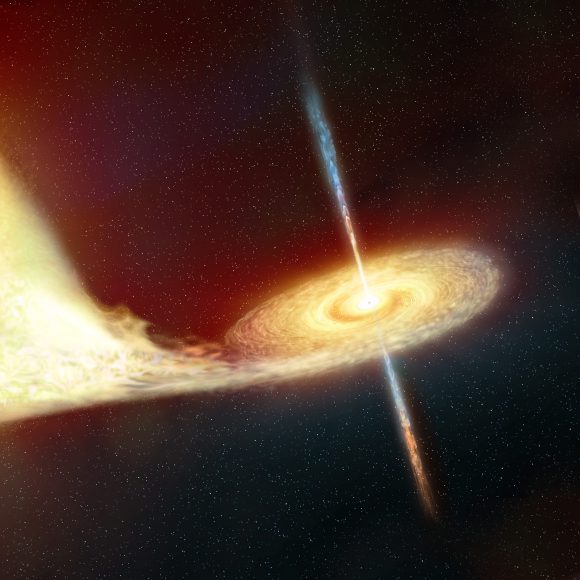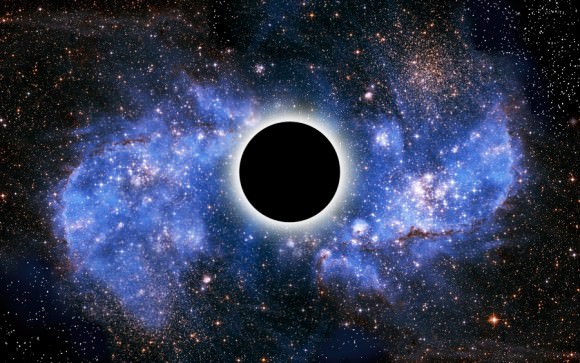Today we’re going to have the most surreal conversation. I’m going to struggle to explain it, and you’re going to struggle to understand it. And only Stephen Hawking is going to really, truly, understand what’s actually going on.
But that’s fine, I’m sure he appreciates our feeble attempts to wrap our brains around this mind bending concept.
All right? Let’s get to it. Black holes again. But this time, we’re going to figure out their temperature.
The very idea that a black hole could have a temperature strains the imagination. I mean, how can something that absorbs all the matter and energy that falls into it have a temperature? When you feel the warmth of a toasty fireplace, you’re really feeling the infrared photons radiating from the fire and surrounding metal or stone.
And black holes absorb all the energy falling into them. There is absolutely no infrared radiation coming from a black hole. No gamma radiation, no radio waves. Nothing gets out.

Now, supermassive black holes can shine with the energy of billions of stars, when they become quasars. When they’re actively feeding on stars and clouds of gas and dust. This material piles up into an accretion disk around the black hole with such density that it acts like the core of a star, undergoing nuclear fusion.
But that’s not the kind of temperature we’re talking about. We’re talking about the temperature of the black hole’s event horizon, when it’s not absorbing any material at all.
The temperature of black holes is connected to this whole concept of Hawking Radiation. The idea that over vast periods of time, black holes will generate virtual particles right at the edge of their event horizons. The most common kind of particles are photons, aka light, aka heat.
Normally these virtual particles are able to recombine and disappear in a puff of annihilation as quickly as they appear. But when a pair of these virtual particles appear right at the event horizon, one half of the pair drops into the black hole, while the other is free to escape into the Universe.
From your perspective as an outside observer, you see these particles escaping from the black hole. You see photons, and therefore, you can measure the temperature of the black hole.

The temperature of the black hole is inversely proportional to the mass of the black hole and the size of the event horizon. Think of it this way. Imagine the curved surface of a black hole’s event horizon. There are many paths that a photon could try to take to get away from the event horizon, and the vast majority of those are paths that take it back down into the black hole’s gravity well.
But for a few rare paths, when the photon is traveling perfectly perpendicular to the event horizon, then the photon has a chance to escape. The larger the event horizon, the less paths there are that a photon could take.
Since energy is being released into the Universe at the black hole’s event horizon, but energy can neither be created or destroyed, the black hole itself provides the mass that supplies the energy to release these photons.
The black hole evaporates.
The most massive black holes in the Universe, the supermassive black holes with millions of times the math of the Sun will have a temperature of 1.4 x 10^-14 Kelvin. That’s low. Almost absolute zero, but not quite.

A solar mass black hole might have a temperature of only .0.00000006 Kelvin. We’re getting warmer.
Since these temperatures are much lower than the background temperature of the Universe – about 2.7 Kelvin, all the existing black holes will have an overall gain of mass. They’re absorbing energy from the Cosmic Background Radiation faster than they’re evaporating, and will for an incomprehensible amount of time into the future.
Until the background temperature of the Universe goes below the temperature of these black holes, they won’t even start evaporating.
A black hole with the mass of the Earth is still too cold.
Only a black hole with about the mass of the Moon is warm enough to be evaporating faster than it’s absorbing energy from the Universe.
As they get less massive, they get even hotter. A black hole with the mass of the asteroid Ceres would be 122 Kelvin. Still freezing, but getting warmer.
A black hole with half the mass of Vesta would blaze at more than 1,200 Kelvin. Now we’re cooking!
Less massive, higher temperatures.
When black holes have lost most of their mass, they release the final material in a tremendous blast of energy, which should be visible to our telescopes.

Some astronomers are actively searching the night sky for blasts from black holes which were formed shortly after the Big Bang, when the Universe was hot and dense enough that black holes could just form.
It took them billions of years of evaporation to get to the point that they’re starting to explode now.
This is just conjecture, though, no explosions have ever been linked to primordial black holes so far.
It’s pretty crazy to think that an object that absorbs all energy that falls into it can also emit energy. Well, that’s the Universe for you. Thanks for helping us figure it out Dr. Hawking.


It’s pretty easy to understand. Heat = energy = movement. Fire is hot because the air molecules are rushing around fairly fast. Black holes are pretty much aboslute zero because there is zero movement due to everything being squished together so much they can’t move. The accrection disk is a different story it will be very hot. There you go an easy to understand explanation under 100 words. . .
Radio telescope data reveals these structures are rotating at phenomenal speed. This makes sense since it must be the massive flow of charged particles within these structures ( “current”) that is generating the measured massive magnetic fields surrounding them.
If you wish to believe in the singularity and the accretion disc that’s fine. These imaginary concepts have no scientific basis (experimental or observational support) and are reducing the field of cosmology to a religion. They exist only due to mathematical salvage missions as Hawkings model continually fails to explain the newest radio telescope data.
One indication that a model is incorrect is that it fails to have predictive value. This model meets that criterion and even worse has required the creation of other equally preposterous theories such as “dark matter”.
Once it is recognized and accepted that gravity cannot be the driving force for star and galaxy formation then the newest data can be realistically evaluated. Considering electromagnetism as the real driving force is a logical alternative. The mysterious “black hole” can then be readily understood as a massive, rapidly rotating plasmoid, which is neither black nor a hole in anything. This concept has the added advantage of being possible within the known laws of physics and does not require dark matter, singularities or accretion discs. There is also experimental evidence to support the model (Anthony Peratt, Los Alamos National Labs). WOW!
“These imaginary concepts have no scientific basis (experimental or observational support) and are reducing the field of cosmology to a religion.”
Exactly false on all counts. At this point you’re either being deliberately misleading, or willfully ignorant. Assume from now on that at least one of your down-votes per comment comes from me until further notice.
From the failure of Hawkings “black hole” model to adhere to new radio telescope data it is apparent that he doesn’t understand these structures. The creation of the “accretion disc” to salvage the model just stacks one illogical concept on top of another.
From the singularity to the accretion disc all of the basic tenets of this model require the known laws of physics to be abandoned.
Let’s at least recognize the findings from the newest radio telescope data on “black holes”. First, they emit massive amounts of electromagnetic radiation. This is mainly in the gamma and xray spectra and now em radiation in the visible light spectrum has now been confirmed. They also emit plasma jets which gives us a real clue to their actual structure. A final observation, and the most important, is that they are encompassed by massive magnetic fields. This strongly implies an equally massive electric current (flow of charged particles) within these structures..
None of these findings was predicted by Hawking’s model. His attempts to salvage his theory in light of these findings is not realistic nor does it even account for the observed data.
These bodies are massive electromagnetic structures, most likely in the form of plasmoids. This theory accounts for all of the observed data and is coherent with the known laws of plasma physics and electrical engineering.
Using gravity as the driving force for their structure is Hawking’s fundamental error. They are not holes nor are they black.
By the way, regarding the “temperature” of a “black hole” My answer is relatively simple although not exact. The surface of these structures will have the highest temperature however, like the sun’s corona, the surrounding outer “atmosphere” will be exponentially hotter. One fact that the standard model inadequately explains is that the surface of the sun is 5000 degrees while the corona is about 2 million degrees. This is totally inconsistent with “nuclear explosions in the core” as a source of the sun’s radiation.
Dr. Donald Scott has elegantly explained these findings. Both galactic centers (“black holes”) as well as stars form due to the intense constriction of intergalactic and insterstellar Birkeland currents by their accompanying magnetic fields. This concept is a well documented principle of electrical engineering called a “Z Pinch”. His model is consistent with all of the latest radio telescope data.
I strongly recommend you take a few minutes and review his presentation to NASA engineers at the 2009 Goddard Colloquim on Engineering. Even NASA astrophysicists were left with the realization that the photos of nebulae they described as “explosions” were actually views of star formation.
The recent documentation of of massive magnetic fields surrounding galaxies, galactic centers and stars (i.e. the sun) was predicted by his model. I guess this is why mainstream cosmologists prefer to ignore this data.
I’m not even much of a fan of the EU model in the Eastern Hemisphere, much less the ridiculous one you’re discussing. Yes, there are holes in astrophysical theories, but they still stand up far more rigorously than the plasmoid star model. Can you see the Sun in space?
There are, undoubtedly, electromagnetic currents and fields in space. Electromagnetism is part of the unified forces, and it is important to most everything at some level. But dismissing gravitational influence in favor of a massive longshot theory of stellar formation is just not science. It’s contrarianism.
Any discussions and theories about the properties of black holes, may not be valid, if they are not familiar with the structure of the universe, observing the natural laws by which we are human beings formed.
Black holes are complete cycles of appearance and disappearance of matter in the universe.
Matter arises from the substance ether, about which knows almost nothing, because it did not matter nor energy. He is immobile and fills the endless universe, including the tiniest subatomic particles such as quarks as the first aspect of the matter. In further process chains (here I will not be at), it comes to the formation of celestial bodies (supernova), and later under the influence of gravity, these materials back into the form of ether (critical mass and critical gravity), and it takes place in black holes . These are places Unlock nothing can escape. What is seen on the horizon of a black hole, this is the limit of the disappearance of matter on the orders of the spiritual entity of the universe (SEU), which represents an immense power to create everything in material and energy entity (MEEU). It is futile to attempt to measure anything in a black hole, because there is not the laws of matter and energy, the bond strength of the Absolute consciousness of the universe (ACU).
i’m confused. you’re claiming that Helium (He) is immobile and fills the Universe. Are you claiming that the whole Universe is so cold that it is near Absolute Zero (0K) ?
Time to start discussing what a Black Hole is again. Some people believe in Myths so easily rather than trying to understand why so many theories do support Black Holes. Just because new data might not fit old models of a Black Hole does NOT mean Black Holes don’t exist. Let’s just say Sagittarius A kind of proves Black Holes exist.
Look here: https://www.youtube.com/watch?v=k7xl_zjz0o8
Something gets out of a black hole — gravity. The trick is what does gravity take with it?
I understand the article, but I have a follow up question/theory. A blackhole continuously consumes matter, collecting energy until its temperature exceeds the temperature of space around it. Then lets apply this to the extremely large blackhole at the center of our universe. Eventually it would have consumed so much of our known universe that its temperature will increase to the point where it starts to evaporate. Finally, it collapses and releases its massive stored energy creating a new universe like the Big Bang. Ultamitely creating a never ending cycle of new universes that happens every trillion years or so. Is this possible? Would this help explain the origin of the Big Bang?
Mmmm, interesting idea, m_apjoke, but the premise is backwards: black holes actually get colder as they get larger (i.e. as they consume more material), not warmer.
In other words, BH do not act as regular “black bodies” like stars & such do by increasing their rate of radiation as they gain in mass/energy — instead they do exactly the opposite. (We’re not speaking of accretion disks here.) As Fraser notes in the video, the “temperature” of a black hole depends on the amount of energy it can emit in the form of virtual particles. These particles can only escape if they appear in locations where there are paths which take one particle into the BH while the other escapes the event horizon entirely. The larger the black hole, the fewer such divided paths there are, & the fewer particles that can escape. As a result a larger BH will not only have a lower temperature, it will take longer for that BH to emit the same amount of energy as a smaller one.
As for the “extremely large blackhole at the center of our universe,” I don’t know of any observations or theories that can determine a location for the “center” of our universe, let alone whether there’s a black hole there or not. Most cosmology indicates there may be no actual “center” at all, but the defined center of the observable universe for us is right here on Earth… unless you’re calling Earth an extremely massive black hole?